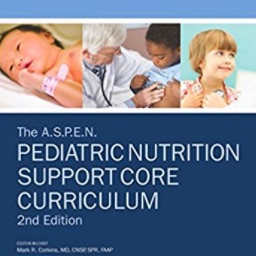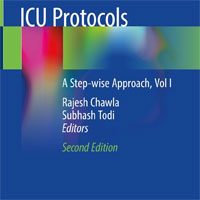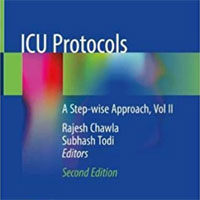Tag: nutrition
The A.S.P.E.N. Pediatric Nutrition Support Core Curriculum
A valuable resource for certification preparation and the daily nutrition care of pediatric patients focusing on the importance of nutrition to the growth and development of children. Written with an interdisciplinary evidence-based... read more

ESPEN Guideline on Clinical Nutrition in the ICU
Following the new ESPEN Standard Operating Procedures, the previous guidelines to provide best medical nutritional therapy to critically ill patients have been updated. These guidelines define who are the patients at risk,... read more
Probiotic and Synbiotic Therapy in the Critically Ill
Recent medical history has largely viewed our bacterial symbionts as pathogens to be eradicated rather than essential partners in optimal health. However, one of the most exciting scientific advances in recent years has been... read more
Intravenous Fish Oil (Omegaven) Approved by FDA
Intravenous Fish Oil (Omegaven) approved by FDA for use in total parenteral nutrition (TPN) in pediatric patients in the United States. Omegaven 10% Emulsion is a fish oil emulsion administered intravenously in patients who... read more
The Intensive Care Medicine Research Agenda in Nutrition and Metabolism
Priorities for clinical research in the field of nutritional management of critically ill patients were suggested, with the prospect that different nutritional interventions targeted to the appropriate patient population... read more
The 11th Pitfall: Thiamine Deficiency
Thiamine deficiency may occur in critically ill patients in case of increased glucose metabolism (i.e., in septic states or post-surgical phases), sudden or aggressive nutrition delivery to malnourished patients (refeeding... read more
New research shows why nutrition should be back on the table for surgical patients
More than 48 million people in the U.S. undergo surgery each year, and for decades the focus has been on making sure patients do not consume any food or drinks in the hours leading up to the surgery. Yet, 1 in 3 patients... read more
Pressure ulcers in ICU patients: Incidence and clinical and epidemiological features
Pressure ulcers in ICU patients: Incidence and clinical and epidemiological features: A multicenter study in southern Brazil. The main objective is to evaluate the incidence and risk factors of pressure ulcers (PU) in adult... read more
Very high intact-protein formula successfully provides protein intake according to nutritional recommendations in overweight critically ill patients
Enteral feeding with VHPF (8 g/100 kcal) resulted in higher protein intake and plasma amino acid concentrations than an isocaloric SHPF (5 g/100 kcal), without an increase in energy intake. This VHPF facilitates feeding according... read more
The Role of Nutrition in Strong for Surgery
Host Paul Wischmeyer is joined by Thomas Varghese, MD, section head of General Thoracic Surgery at the University of Utah, to discuss the role of nutrition in the American College of Surgeons’ Strong for Surgery initiative.... read more
Trophic or Full Nutritional Support?
A two-phase approach for nutritional support may more appropriately account for the physiologic changes during critical illness than one-phase approach. Further evidence is awaited for the optimal protein amount during critical... read more
Measuring and Monitoring Lean Body Mass in Critical Illness
Methods to monitor lean body mass in the ICU are under constant development, improving upon bedside usability and offering new modalities to measure. This provides clinicians with valuable markers with which to identify patients... read more
Oxygen: Savior or Devil in a Green Dress?
If you ask any small child what doctors do or what happens in a hospital, you'll probably get some variation of "they make sick people better." Were you to ask the same question of one of those doctors or someone working... read more
Excess dietary zinc worsens Clostridium difficile infection
The consumption of dietary supplements and cold therapies containing high concentrations of zinc is now being called into question, following research that suggests it may worsen Clostridium difficile infection. The findings... read more
When Should Nutritional Support Be Implemented in a Hospitalized Patient?
At the time of admission to the hospital, malnutrition is already present in over 20% of patients. Hospitalized patients are particularly susceptible to developing malnutrition because of increased catabolic states in acute... read more
Stress Ulcer Prophylaxis in ICU Patients Receiving Enteral Nutrition
Our results suggested that in patients receiving enteral feeding, pharmacologic SUP is not beneficial and combined interventions may even increase the risk of nosocomial pneumonia. We searched PubMed, Embase, and the Cochrane... read more
Consensus Statement on Nutrition Screening and Therapy Within a Surgical Enhanced Recovery Pathway
Perioperative malnutrition has proven to be challenging to define, diagnose, and treat. Despite these challenges, it is well known that suboptimal nutritional status is a strong independent predictor of poor postoperative... read more
Enteral vs Parenteral Nutrition in Critical Care Requiring Mechanical Ventilation
Enteral feeding was not superior to parenteral feeding for early nutritional support in critically ill patients receiving mechanical ventilation and vasopressor support for shock, according to the results of a study published... read more
Supplemental Parenteral Nutrition vs. Usual Care in Critically Ill Adults
This individually titrated supplemental PN strategy applied over 7 days significantly increased energy delivery when compared to usual care delivery. Clinical and functional outcomes were similar between the two patient groups.... read more
Nutrition Therapy – One Size Does Not Fit All
A review paper published in Critical Care highlights the importance of employing targeted nutritional care for critically ill patients. The sad truth, according to the article, is that current ICU nutrition delivery worldwide... read more
Probiotics Offer Powerful Protection Against Sepsis in Infants
Sepsis can occur in just about anyone, including infants. Recent research shows feeding newborns probiotics (healthy bacteria) significantly lowers the child's risk of developing sepsis. The study involved infants in rural... read more
Hospitalist Tackles Chronic Disease With Food Pharmacies
Before January 2017, Rita Nguyen, MD, was "pretty much like any other academic hospitalist," she says. In the hospital, she could provide excellent care to patients, but once they were discharged, many didn't have the necessary... read more









